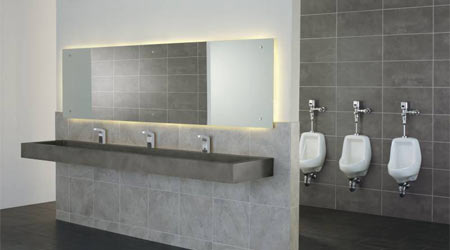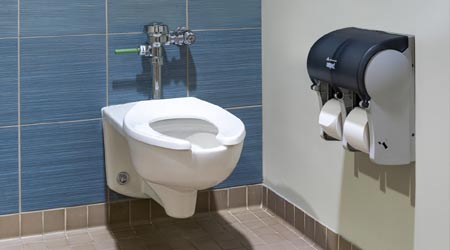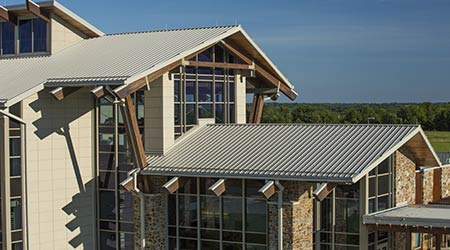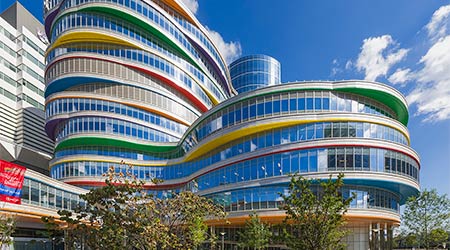view all Case Studies
One Piping To Fix Them All On Growing College Campus

Southern Adventist University in Collegedale, Tenn., has been renovating campus buildings and specifically retrofitting piping projects since 2011. The university was originally founded with 23 students in 1892 as Graysville Academy in Graysville, TN, and has grown considerably since, registering a record 3,053 students in 2010. The university’s growth meant various school facilities needed to be renovated and expanded and a new structure had to be built.
August 8, 2016 -
Plumbing & Restrooms
Southern Adventist University in Collegedale, Tenn., has been renovating campus buildings and specifically retrofitting piping projects since 2011. The university was originally founded with 23 students in 1892 as Graysville Academy in Graysville, TN, and has grown considerably since, registering a record 3,053 students in 2010. The university’s growth meant various school facilities needed to be renovated and expanded and a new structure had to be built.
As part of the many improvements, several of the buildings’ piping systems required upgrades. When the administration began to focus on the modernizations, Dave Allemand, the university’s Associate Director of Plant Services—Building Systems Management, knew he would need to specify piping that could work for many types of projects. He tasked his lead plumber, Tim Mitchell, with researching piping options.
Mitchell was introduced to Aquatherm polypropylene-random (PP-R) piping systems and learned that PP-R piping won’t corrode, scale, wear out or clog—even after years of use; hard water doesn’t affect the piping, making it ideal for almost any application. Additionally, Aquatherm piping systems are completely free of heavy metals and toxic chemicals; they also are hydrophobic, which means they will not leach chemicals into the water. Another issue eliminated by PP-R is electrolysis, which often occurs with metal piping systems.
“I liked a lot of the possibilities of how it could work in our applications,” Mitchell said. And Mitchell had many projects to consider:
• Talge Hall, originally built in 1961 as a women’s dormitory and now a men’s residence hall with 383 rooms, needed a new domestic-hot-water piping system as well as bathroom renovations on three floors. Mitchell and an outside contractor installed a 1.4-MMBtu Lochinvar Copper Fin II boiler and used 130 feet of 2½-in. Aquatherm SDR 7.4 Green Pipe (the green pipe with the green stripe that denotes its ability to handle higher temperatures) to connect three 200-gallon storage tanks. The boiler circulates 135 F water to the first tank; the water then is routed to the other two tanks, diluted to 125 F and sent to various distribution points. About 120 feet of 2½-in., 180 feet of 2-in., 260 feet of 1-in., 200 feet of ¾-in. and 100 feet of ½-in. Green Pipe was used for the bathroom improvements.
Engineered specifically for hot-water use, Aquatherm’s Green Pipe with multilayer faser (MF) improves impact resistance and reduces linear expansion and contraction by about 75 percent compared with other plastics.
• Thatcher Hall, originally constructed in 1968 and currently a women’s residence hall with 257 rooms, also required a new domestic-hot-water piping system. Mitchell and outside contractor David Smith Plumbing from Ooltewah, TN, constructed a similar setup and again installed a 1.4-MMBtu Lochinvar Copper Fin II boiler using about 156 feet of 2½-in. Green Pipe with MF to service three 200-gallon storage tanks.
• Ledford Hall, which holds hands-on classes in its 10-bay auto-repair shop and drafting, graphics, welding, woodworking and lighting labs, needed new piping for an updated hydronic heating application. Mitchell created a hot loop for radiator-type heaters, running 150 -168 F water through 600 feet of 2-in. Green Pipe with MF at 50 psi.
PP-R piping has natural insulation properties, and Aquatherm’s piping with MF has a low thermal conductivity. “I wanted to use Aquatherm as much as possible because I didn’t have to go through and insulate anything,” Mitchell said. “I can put my hand on the Aquatherm and not be burned, even when 160 F water is running through it.”
• The Hulsey Wellness Center opened its doors in 2008 as the university’s fitness facility. Even though the building was relatively new, two projects were necessary. A large galvanized steel piping line running underneath the center already had ruptured a couple of times due to corrosion, and Mitchell wanted to replace it with another product rather than continue to commit to future costly repairs. Instead of digging up the concrete floor—another pricey solution—Mitchell hung 300 feet of 3-in. Green Pipe with MF from the ceiling in Walraven hangers for a domestic cold water line, 100 feet of which was suspended over an Olympic-sized swimming pool.
“This project was one of the reasons I chose Aquatherm in the first place,” Mitchell said. “I didn’t have to worry about the chlorine in the air eating the Aquatherm pipe, and I didn’t want to run steel pipe because it was so heavy. When I compared the weight of the Aquatherm to the steel pipe, it’s 6 lb/ft versus 28 lb/ft. The Aquatherm is easy to move, and you don’t have to worry about people getting hurt.”
The piping supplies the center’s locker rooms and bathrooms, which also were renovated. Mitchell used 250 feet of 2½-in., 250 feet of 1-in., 100 feet of ¾-in. and 150 feet of ½-in. Green Pipe with MF for the updates.
Although Mitchell could have used the less expensive Aquatherm non-MF Green Pipe SDR 11 (the green pipe with the blue stripe), which is designed for cold-water use, he preferred to use only one type of the piping for simplicity. The MF Green Pipe actually exceeds the requirements for cold-water applications.
“That way I can just keep it in stock,” Mitchell said. “I don’t have to worry about someone grabbing the wrong thing.”
• Finally, the McKee Library, which originally opened in 1970, needed a new chiller and associated piping for an HVAC application. This project was especially unique. According to Mitchell, the outside contractor was unfamiliar with Aquatherm and preferred to use steel pipe when he installed the chiller on the outside of the building; it took him three months to complete the project.
However, when it was time to install piping on the inside of the building, Allemand stepped in. First, he was concerned about the length of time the library would have to be shut down to weld the entire steel-piping system. Second, the library hosts an assortment of valuable materials and artifacts related to former President Abraham Lincoln and the Civil War, called the Thomas Memorial Collection, on the third floor; Allemand was worried about the risk of a fire starting when welding steel pipe so close to irreplaceable objects.
“We would have had to shut down the library, vacate it and get burn permits,” Allemand said.
Instead, Mitchell and outside contractor Industrial Air & Mechanical Contractors, with offices in East Ridge, TN, and Dalton, GA, ran 143 feet of 3-in., 78 feet of 1¼-in. and 52 feet of ¾-in. Blue Pipe from the steel boiler and chiller loops in the basement up to the four HVAC units on each of the three floors.
Because Aquatherm PP-R piping is joined using a unique and quick heat-fusion welding process, both of Allemand’s problems were solved: No open flames were necessary, and the library’s downtime was minimized.
“They were able to install the Aquatherm in two weeks,” Allemand said. “It would have taken an additional three weeks if we had used steel. We eliminated all of that hassle and downtime by using Aquatherm.”
“It takes me five minutes to do two 3-inch connections at a 90-degree joint with Aquatherm,” Mitchell said. “That would take me an hour and a half to weld with steel.”
Aquatherm uses reliable heat fusion to form connections; heat fusion bonds both sides of a joint into a single, homogenous material without the use of chemicals or mechanical connections, which eliminates systematic weaknesses and fail-points in the pipe. The seamless heat-fusion connections, combined with the piping’s resistance to corrosion and abrasion, help to ease leakage concerns.
“I like that it’s not a glue fitting,” Mitchell said. “I hate glue fittings for any type of pressure piping because that’s where the leaks come from. I haven’t had any problems with leaks with the Aquatherm. If you fuse it and test it like they tell you to, you won’t have any issues with leaks.”
Next
Read next on FacilitiesNet












